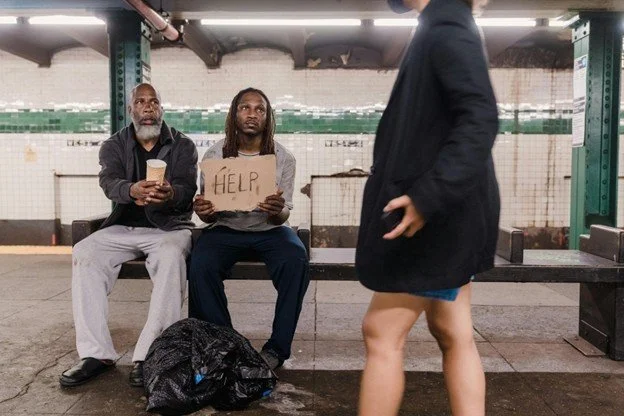Why We Don't Help: Understanding the Bystander Effect
By Grace Rodriguez
Why do people stand by when others need help? Social psychology has the answer, and it could save lives.
Have you ever witnessed something troubling—someone getting bullied, a person suddenly collapsing in public, or a serious situation unfolding—and hesitated to help? You may have experienced something called the bystander effect.
This psychological phenomenon explains why people are less likely to intervene in an emergency when others are present. The key reason? Diffusion of responsibility: We assume someone else will take action, so we don’t. This effect has been documented across decades of social psychology research, with powerful implications for real-world safety, violence prevention, and community care.
Why the Bystander Effect Matters
The bystander effect isn’t just a lab experiment; it shows up everywhere: in schools, on streets, online, and in moments that can drastically change or even end lives. From violent crimes to bullying to harassment, people often fail to act simply because others are around.
This is more than a quirk of human nature; it’s a barrier to compassion. Recognizing and understanding this behavior can help people override their hesitation and act more responsibly during the moments that count. In fact, simply knowing about the bystander effect is the first step toward stopping it.
What Research Tells Us
1. Barriers and Motivators: Why People Don’t Step In
In a 2013 study, Bennett, Banyard, and Garnhart explored what prevents people from intervening. Their research showed that bystanders often weigh the risk to themselves, uncertainty about the situation, and social discomfort before acting. On the other hand, factors like a strong sense of moral responsibility or prior training encouraged intervention (Bennett et al., 2013).
Key takeaway: People don’t always lack empathy—they may just feel unsure, afraid, or unprepared.
2. When Danger Makes a Difference
Fischer and colleagues (2011) reviewed over 50 studies in a meta-analysis and found that the level of danger matters. In high-danger emergencies, people are more likely to help, especially when they feel that someone's life is at risk. But in low-risk, ambiguous situations, the bystander effect is much stronger (Fischer et al., 2011).
Key takeaway: When the stakes are clear and high, people are often braver.
3. Bystanders in Real Life: The Murder of George Floyd
In a powerful recent study, Levine et al. (2025) analyzed bystander behavior during the police killing of George Floyd. Their research highlighted the moral courage shown by bystanders who spoke out, even in the face of authority. Yet their inability to physically intervene shows how social and systemic power dynamics shape the bystander effect in real-world, high-stakes contexts (Levine et al., 2025).
Key takeaway: Sometimes bystanders do speak up, but they need support and structural protection to make a difference.
From Knowledge to Action: What Can We Do?
Understanding the bystander effect can help us train ourselves to act instead of freeze. That’s why certain colleges and workplaces now offer bystander intervention training. These programs help people recognize harmful behavior, take safe action, and build confidence in stepping up.
Here’s how you can apply this knowledge:
Don't assume someone else will help—assume it’s your responsibility.
Call someone out directly (e.g., “You in the blue shirt, please help me with this!”).
Practice empathy and preparation—even thinking through what you’d do can improve your response.
Encourage your school or job to offer training programs on intervention and response.
Final Thoughts
The bystander effect shows how social influence can quietly shape our actions (or inactions), often leading us to stay silent when others need help. But understanding this effect gives us the power to respond differently. Awareness helps us pause, reflect, and take action even when it feels uncomfortable.
The next time you see something wrong, remember: your decision to step up matters. Whether it’s in public, at school, online, or in your neighborhood, choosing to act instead of looking away can make a real difference. It might not just change someone’s day, it could end up saving their life.
References
Bennett, S., Banyard, V. L., & Garnhart, L. (2013). To act or not to act, that is the question? Barriers and facilitators of bystander intervention. Journal of Interpersonal Violence, 29(3), 476–496. https://doi.org/10.1177/0886260513505210
Fischer, P., Krueger, J. I., Greitemeyer, T., Vogrincic, C., Kastenmüller, A., Frey, D., Heene, M., Wicher, M., & Kainbacher, M. (2011). The bystander-effect: A meta-analytic review on bystander intervention in dangerous and non-dangerous emergencies. Psychological Bulletin, 137(4), 517–537. https://doi.org/10.1037/a0023304
Levine, M., Walton, C., Philpot, R., & Keil, T. (2025). Bystanders and the murder of George Floyd: Analyzing bystander intervention in the course of a police killing. American Psychologist. https://doi.org/10.1037/amp0001531

